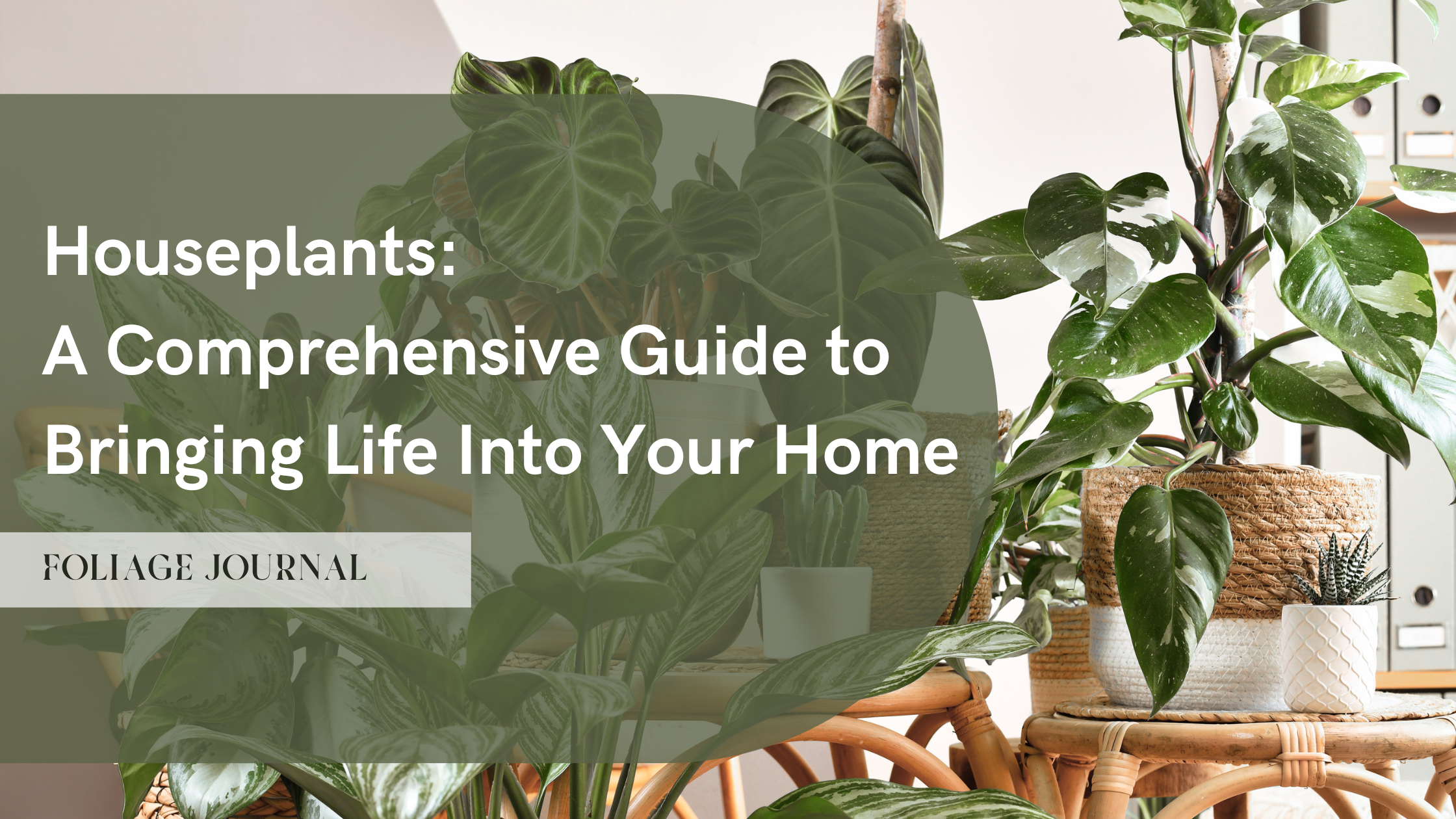Introduction
Houseplants have taken over Instagram feeds, Pinterest boards, and even the corners of our living rooms—and for good reason. Not only do they add a touch of greenery and life to our spaces, but they also have numerous health benefits.
If you’re new to the world of houseplants or just looking to expand your leafy family, you’ve come to the right place.
In this comprehensive guide, we’ll explore why houseplants are a must-have decoration in any home, how to choose the right ones for your space, and much more.
Why Houseplants Are a Must-Have Decoration in a House

Houseplants are more than just a trend; they’re an essential part of modern living. Here’s why:
- Aesthetic Appeal: Houseplants can be the perfect accessory to complement your home decor, adding a pop of color and texture to any room.
- Clean Air: Plants like the Snake Plant and Spider Plant are known to purify air, filtering out common volatile organic compounds (VOCs).
- Mental Health: Studies have shown that tending to plants can reduce stress and promote a feeling of well-being.
- Humidity: Houseplants can increase humidity in your home, which is especially beneficial in dry climates or during winter months when the heater can make indoor air quite dry.
- Focus and Productivity: Believe it or not, having plants in your workspace can improve concentration and productivity by up to 15%.
What Houseplants Are Right for You?
Planning to add houseplants to your home might be exciting, but choosing the right houseplant for you is quite challenging.
Before you head to the nursery or start browsing online plant shops, consider the following factors:
- Light Requirements: Some plants need lots of light, while others can tolerate lower light conditions. Assess the lighting situation in your home first.
- Watering Schedule: From succulents that need minimal water to tropical plants that love moisture, make sure you can commit to the watering needs of your chosen plant.
- Size: Plants grow. Make sure you have adequate space for the plant as it matures.
- Pet-Friendly: Some houseplants can be toxic to pets. If you have fur babies, make sure to choose plants that are safe for them.
Popular Picks: Most Common Houseplants
| Snake Plant (Sansevieria trifasciata) | Exceptionally low maintenance, Snake Plants are known for their upright, sword-like leaves. They’re excellent air purifiers and can thrive in low-light conditions. |
| Pothos (Epipremnum aureum) | With heart-shaped leaves, Pothos is one of the best plants for beginners. It is highly adaptable and can even grow in water. |
| Succulents | These plants require minimal care, making them perfect for forgetful plant owners. Aloe and Echeveria are popular types within this category. |
| Ficus (Ficus spp.) | Whether you opt for a Fiddle Leaf Fig or a Rubber Plant, Ficus trees are generally easy to care for and come in various leaf shapes and sizes. |
| ZZ Plant (Zamioculcas zamiifolia) | Its ability to thrive in a variety of conditions. It can tolerate low light, infrequent watering, and a range of temperatures, making it an ideal choice for novice plant owners or those with less-than-ideal plant environments. |
| Spider Plant (Chlorophytum comosum) | Known for its long, arching leaves, the Spider Plant also produces “babies” that are easy to propagate. |
| Peace Lily (Spathiphyllum) | Not only do these plants have beautiful white flowers, but they also help clean the air. |
| Aloe Vera | This plant is not just an attractive green addition to your home but also has medicinal properties. |
| Jade Plant (Crassula ovata) | Known for its thick, woody stems and oval-shaped leaves, the Jade Plant is often considered a symbol of good luck. |
| Monstera Deliciosa | Famous for its unique, split leaves, Monstera is relatively easy to care for and can make a big statement in any room. |
Treasure Trove: Rare Houseplants
- Monstera Obliqua: Highly sought after for its unique, hole-ridden leaves, this plant is a collector’s dream.
- String of Hearts (Ceropegia woodii): This trailing plant has beautiful, heart-shaped leaves and is perfect for hanging planters.
- Variegated Rubber Plant (Ficus elastica variegata): Unlike its more common sibling, this variety has gorgeous variegated leaves with streaks of white or yellow.
- Pink Princess Philodendron: Known for its stunning pink variegated foliage, this plant has gained a cult following among houseplant enthusiasts.
- Calathea ‘White Fusion’: This Calathea variety has striking white variegated leaves and is a little tricky to care for, making it a plant for seasoned enthusiasts.
- Hoya Kerrii ‘Variegata’: The heart-shaped leaves of this Hoya are charming, but the variegated version is especially prized.
- Alocasia ‘Black Velvet’: This plant has almost surreal, dark velvety leaves, making it an exotic addition to any collection.
- Euphorbia Obesa: Also known as the Baseball Plant, it’s a rare succulent that resembles a ball.
- Begonia Maculata: Known as the Polka Dot Begonia, it has spotted leaves and red undersides. It’s a showstopper but requires precise care.
- Watermelon Peperomia (Peperomia argyreia): Its leaves resemble watermelon skin, making it a quirky yet stunning houseplant.
Adding these more detailed lists should offer readers a great starting point for both common and rare plants to consider for their homes. It provides a range of options, whether they are new to houseplant care or looking to expand their existing collections.
Caring for Your Houseplants

Caring for your houseplants is a rewarding journey that goes beyond mere aesthetics. These green companions not only enhance the ambiance of your living space but also contribute to improved air quality and mental well-being.
To ensure their optimal growth and health, it’s essential to understand each plant’s specific needs. From the right amount of sunlight to the correct watering frequency, soil type, and humidity levels, every detail matters.
Watering
The single most crucial aspect of plant care, yet often the most misunderstood. Overwatering can lead to root rot, a fatal condition. On the other hand, underwatering can cause leaves to dry out and fall off. To strike the right balance:
- Use a moisture meter or your finger to check the soil’s moisture level. If it’s dry up to an inch below the surface, it’s time to water.
- Employ the “bottom watering” technique for certain plants to ensure the roots get adequate moisture.
- Use distilled or filtered water if your tap water is hard, as certain plants are sensitive to minerals.
Light
Sunlight is essential but too much can be harmful:
- Use sheer curtains to diffuse strong sunlight for plants that prefer indirect light.
- For plants that need lots of light, consider placing them near south-facing windows.
- Light meters can help you accurately gauge whether your plants are getting enough light.
- Rotating your plants every few weeks can ensure even growth.
Soil
The right soil can make or break your plant’s health:
- Fast-draining soil is essential for succulents and cacti.
- Tropical plants often prefer soil that retains moisture but is also well-draining.
- Consider repotting your plant every year or two to refresh the soil and inspect the roots.
Feeding
Fertilizing is an art form:
- Liquid fertilizers are easier to control and can be diluted to suit different plants.
- Slow-release granules can provide nutrients over a longer period.
- Don’t fertilize during the winter months when most plants are in a dormant stage.
Common Diseases and Pests

Houseplants, while a delightful addition to any space, are not immune to the challenges posed by common diseases and pests.
Fungal infections, such as powdery mildew and root rot, can manifest when plants are subjected to excessive moisture or poor ventilation.
Bacterial and viral diseases can lead to discolored or distorted foliage.
On the pest front, spider mites, aphids, and mealybugs are frequent culprits, often leaving behind telltale signs like webbing, sticky residues, or cottony masses.
Regular inspection of your plants, ensuring proper watering practices, and maintaining cleanliness can mitigate many of these issues.
If infestations or infections do occur, early detection and intervention are key to restoring your plant’s health.
Spider Mites
Tiny but mighty, these pests suck the life out of your plants:
- Regularly mist your plants and wipe the leaves to create an environment that’s less hospitable to spider mites.
- Insecticidal soap or neem oil can help control an infestation.
Fungal Diseases
Common in overwatered plants:
- If your plant has root rot, you might need to remove it from the pot and cut away the affected roots.
- Use fungicides cautiously, and as a last resort.
Aphids
Small and destructive:
- Introduce beneficial insects like ladybugs to your indoor garden as a natural control measure.
- Insecticidal soaps and neem oil can also be effective treatments.
Styling Your Houseplants at Home
Shelves

Styling houseplants at home is an art that marries aesthetics with the natural beauty of greenery.
When thoughtfully arranged, plants can transform a space, creating pockets of tranquility and visual interest. Consider the size and shape of each plant: tall plants like fiddle leaf figs can serve as statement pieces in corners, while trailing plants like pothos or string of pearls elegantly drape from shelves or hanging planters.
Play with levels by using stands, wall mounts, or multi-tiered shelves. Group plants with varying textures and shades of green for a layered look but ensure each plant’s light and space needs are met.
Don’t forget decorative pots and containers that complement your interior decor. Remember, the goal is to create a harmonious blend of nature and design, making your living space a verdant sanctuary.
Floating shelves and ladder shelves aren’t just for books:
- Use these to create a layered look for your plants.
- Consider using stylish brackets and quality wood for a polished appearance.
Hanging Planters
Ideal for those limited on floor space:
- Macrame hangers can add a vintage touch.
- Geometric metal frames can offer a modern aesthetic.
Grouping
A single plant can look lonely, but a group can look like a well-planned garden:
- Mix and match different shapes and sizes for visual interest.
- Use various pots and planters to add different textures and colors to the grouping.
- Consider using a large, statement plant as the centerpiece and smaller ones to accentuate it.
These added details should provide a more comprehensive guide to houseplant care, common diseases, and how to style them in your home. Remember, each plant is unique, so always be ready to adapt your care routine as you learn more about your leafy friends.
Conclusion
From their aesthetic appeal to their health benefits, there’s no doubt that houseplants are a must-have decoration in any home. The key is to choose the plants that fit your lifestyle and can thrive in the conditions you can provide. With a bit of research and a lot of love, your home can become a plant paradise.
So, what houseplants are right for you? Your green sanctuary is just a decision away!
And there you have it, fellow plant lovers! Your ultimate guide to houseplants. If you found this article helpful, make sure to share it with other aspiring plant parents. Happy planting!

